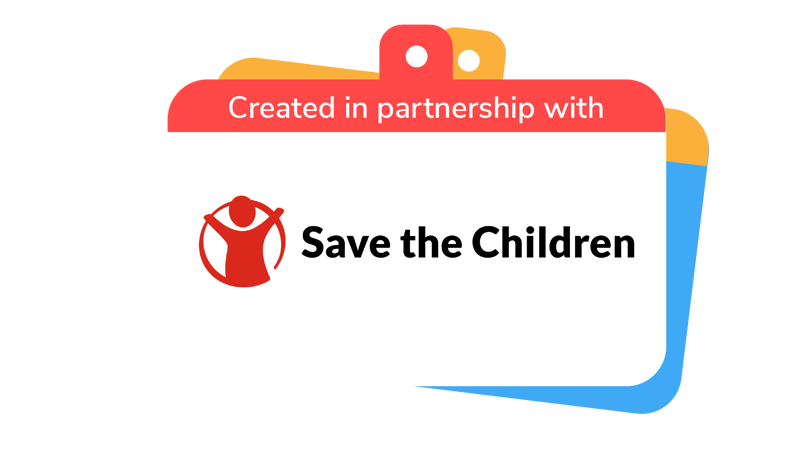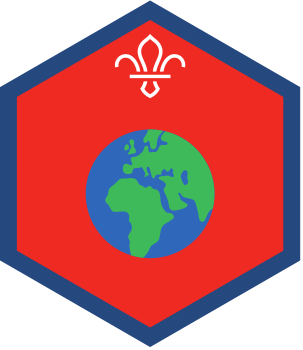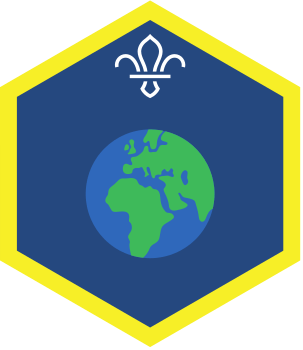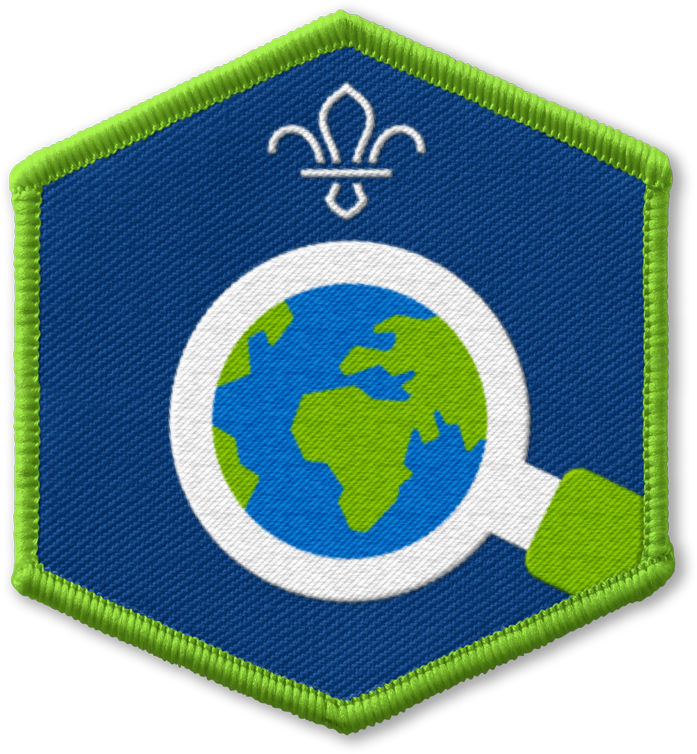
Make welcoming messages
You’ll need
- Coloured pens or pencils
- Craft materials (for example, tissue paper, pipe cleaners, stickers)
- A4 paper or A4 card
- Camera or scanner
Before you begin
- Use the safety checklist to help you plan and risk assess your activity. Additional help to carry out your risk assessment, including examples can be found here. Don’t forget to make sure all young people and adults involved in the activity know how to take part safely.
- Make sure you’ll have enough adult helpers. You may need some parents and carers to help if you’re short on helpers.
Planning this activity
- You might like to run the Welcome new arrivals activity to help people think about how important it is to make people feel welcome when they arrive somewhere new.
Talk about refugees and displaced children
- Explain that while some countries, such as Ukraine, may currently be in the news, there are lots of different conflicts and crises around the world that force adults and children to have to leave their homes. Sometimes they have to go to a different country to find safety. The UK is one of many countries that people might choose to seek safety in. We can all help to make people arriving in this country feel welcome.
- Ask people why they think it's important to make people feel welcome. It can be scary or confusing arriving somewhere new. Refugees and displaced children are often new arrivals more than once, in different situations, and may face extra barriers, such as having to learn a new language and get used to a new culture. It's even more important to make them feel welcome.
- Tell everyone that they’re going to create welcoming messages for refugees and displaced children to read when they arrive in the UK.
- People should decide what are the most important things they want to include in their welcoming message and what it will look like. It's up to you how simple or detailed you make your messages. They should think about:
- What different things that people should know about the UK if they are new to this country?
- If you were arriving into this country or moving to a new country for the first time, what would you want to know? You could think about some important facts. For example, you might want to tell them what the four nations that make up the UK are.
- What things that are important to them that they would want to share with people who are newly arriving to the UK? For example, you could think about your favourite food, game or sports team.
- What would you like to share with children or young people arriving from other countries that helps them understand what life is like for young people in the UK?
- For many people arriving in the UK, English may not be their first language. They may not know any English at all when they first arrive. How can you make your message easy for everyone to understand?
Create your messages
- Remind everyone to remember, the messages will be seen by refugees arriving in the UK from different parts of the world, so try to make sure your messages are welcoming to all young refugees, no matter what country they come from. You may not want to include flags on the messages.
- Ask people to think are you going to present their message. Some things to think about include - will it be a picture or words? What materials will you use? Could they create some drawings to illustrate your ideas? Could you use photos to create a collage and cut out photos to glue on?
- People should create their welcoming message, with drawings and illustrations. Get creative!
Share your messages
- Gather the finished welcoming messages from the different groups.
- Everyone could talk about how to share the messages. You could place them someone in your local community or put them in your windows at home.
- You could also share images on social media, as long as you’ve the photography permissions in place. Remember to follow the Digital Safeguarding guidelines when sharing images or videos online, too.
- The full name of our country is The United Kingdom of Great Britain and Northern Ireland. This means that the United Kingdom, often called the UK, is made up of four countries: England, Scotland, Wales and Northern Ireland.
- The capital cities are London (England), Edinburgh (Scotland), Cardiff (Wales) and Belfast (Northern Ireland).
- English is the main language in the UK, but you might also hear Welsh in Wales, Gaelic in Scotland, and Scots in Scotland and Ireland.
- You also may hear many other languages spoken by people and families in the UK too, such as Polish, Punjabi, Urdu, French, Gujarati and Arabic.
- Queen Elizabeth is the longest reigning British monarch in history. 2022 marks the Queen’s Platinum Jubilee, which is the 70th anniversary of her becoming Queen.
- The head of the UK government is known as the Prime Minister and they live at 10 Downing Street in London.
- The UK is a representative democracy. This is where citizens within a country elect representatives to make decisions for them.
- There are also local governments in Scotland, Wales and Northern Ireland, who are given power to make some decisions in these countries.
- The UK is a multi-cultural and multi-faith place. People in the UK are from many different cultures and backgrounds. There are lots of different faiths and beliefs, too. The top faiths or beliefs in the UK are Christianity, Irreligion, Islam, Hinduism, Sikhism and Buddhism.
- The currency in the UK is pound sterling. One British pound is made up of 100 pennies.
- The Lion is the national animal, the Union Jack is the national flag, and the national colours are blue, white and red.
- Using a scanner or a printer/photocopier with this function probably the best way to get a clear image of your messages.
- If you’re taking a photo instead, make sure the area you’re taking the photo in has enough light and avoid capturing shadows on the image. Use natural daylight if possible.
- Keep your camera, device or mobile parallel to your messages while taking the photo. You might have to prop your messages up against a wall instead of taking a photo from above, so that you don't get the shadow of your hand and the device in the image.
- Avoid compressing the image or reducing the file size, as this will reduce the resolution. The best images are high-resolution, which are crisp and clear, with a high density of pixels. Pixels are the tiny dots of colour that make up an image.
- The best way to keep your image high-quality is by transferring the image using Bluetooth, downloading directly with a cable, or sharing on an online cloud. Try to avoid sending messages through a messaging service.
- Remember, images must not include any personal or identifiable information. This means making sure there are no names of young people or members, any photographs of people’s faces or other identifying features. However, you can include the name of your group, District or County/Area if you would like to.

This activity helps contribute towards some of the UN's Sustainable Development Goals. (SDGs) Find out more about the SDGs and how Scouts across the world are getting involved.
Reflection
This activity was about helping your wider community to welcome new members and about how we can show care and compassion to others.
Everyone could think about how they felt last time they were a new arrival somewhere and how they were welcomed. It may have been starting at a new school, moving house or joining the Scout group. How might you be feeling if you’re a new arrival, and how would receiving welcoming messages make you feel?
Safety
All activities must be safely managed. You must complete a thorough risk assessment and take appropriate steps to reduce risk. Use the safety checklist to help you plan and risk assess your activity. Always get approval for the activity, and have suitable supervision and an InTouch process.
- Scissors
Supervise young people appropriately when they’re using scissors. Store all sharp objects securely, out of the reach of young people.
- Glue and solvents
Always supervise young people appropriately when they’re using glue and solvent products. Make sure there’s plenty of ventilation. Be aware of any medical conditions that could be affected by glue or solvent use and make adjustments as needed.
- Online safety
Supervise young people when they’re online and give them advice about staying safe. Take a look at our online safety or bullying guidance. The NSPCC offers more advice and guidance, too. If you want to know more about specific social networks and games, Childnet has information and safety tips for apps. You can also report anything that’s worried you online to the Child Exploitation and Online Protection Command. As always, if you’ve got concerns about a young person’s welfare, including their online experiences, follow the Yellow Card to make a report.
It's up to you how simple or detailed you make your messages. For younger groups, you may want to work together to create a simple welcoming sign, with a simple phrase or word. You can then get everyone involved in decorating it.
This activity could also be done individually or as a whole group. Why not get other local groups involved in creating welcoming messages too?
This activity may be difficult for people who have experience of being a refugee or displaced child. They might also be keen to share their experiences and ideas. Speak to them and their parent or carer beforehand, so that you can create a plan for how to make it a manageable and comfortable session for them. For example, would they prefer to share their experience or not? And are there any specific examples or situations you should avoid mentioning?
People can work together when creating their messages. Everyone can be involved in whatever way is best for them, whether it’s writing, drawing, colouring, coming up with ideas or helping to organise things.
All Scout activities should be inclusive and accessible.
Find out more about refugees and displaced children on Save the Children's website
You could share a photo of your group with their welcome messages on social media and see what other groups have created. You could even turn your welcome messages into a video. Don't forget to follow the Digital Safeguarding guidelines when sharing images or videos.
How can you make sure that refugees and displaced children know they are welcome in your community? You might like to run the Welcoming signs activity to create signs to display around your area to show that refugees are welcome.
You might also like to think about the practical things that refugees and displaced children may need when they arrive in a new place that they aren’t familiar with. Emoji maps and Caring map are two activities you could try to get people to think about their local area and what the most important places for new people to know about are.
Discover more at https://www.savethechildren.org.uk/
Everyone can be involved in sharing their ideas and experiences to create messages that they are proud of.



